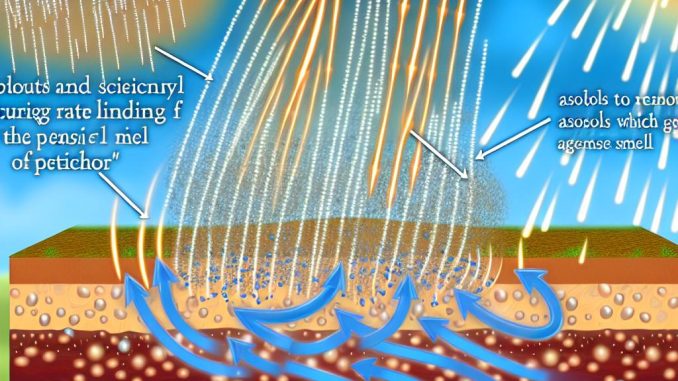
The Science Behind the Smell of Rain
The experience of detecting that unique smell that emerges following a rain shower is both familiar and intriguing to many. This characteristic aroma, often termed as “petrichor,” can be traced back to scientific phenomena involving interactions between particular chemicals and environmental conditions. By examining petrichor through a scientific lens, a deeper understanding of this olfactory experience can be gained.
Understanding Petrichor
The term petrichor refers to the distinctive earthy aroma that intensifies when raindrops impact dry soil. This term was introduced to the scientific community in 1964 by Australian researchers Isabel Joy Bear and R.G. Thomas. They identified that this unique smell is primarily produced through a complex interplay of various chemical compounds that emerge due to specific environmental triggers and biological processes.
The Role of Geosmin
At the heart of petrichor is a compound known as geosmin. This organic compound is characterized by its earthy flavor and odor. Geosmin is synthesized by specific soil-dwelling bacteria, most notably those belonging to the genus Streptomyces. These bacteria release geosmin as part of their routine metabolic activities. When raindrops collide with the ground, the kinetic energy displaces air pockets in the soil, effectively releasing geosmin into the air. This release is what allows the perceivable earthy scent to be detected by our olfactory senses.
Oil Secretion of Plants
Geosmin is not the lone contributor to petrichor. The oils secreted by various plants during dry spells play a significant role as well. These natural oils accumulate on both soil and rocky surfaces during arid periods. The onset of rain washes these oils away, blending with geosmin to contribute to the overall recognizable fragrance commonly associated with rain’s arrival. This symbiotic relationship between soil bacteria and plant oils is central to the formation of the petrichor scent.
The Role of Ozone
Additionally, the compound ozone can be discerned amidst rain showers. Before the rain commences, atmospheric lightning discharges have the potential to split oxygen and nitrogen molecules. This molecular disruption leads to the formation of nitric oxide, which further interacts with surrounding atmospheric chemicals to create ozone. For many people, the presence of ozone imparts a characteristic sharp, fresh smell, which is sometimes mistaken as part of the rain’s scent itself.
Environmental and Psychological Effects
While the smell of rain, known as petrichor, is fundamentally a chemical reaction, it also wields effects that transcend the bounds of chemistry by influencing human psychology. This particular scent can evoke calming and nostalgic emotions within individuals. The link between these feelings and the scent is likely attributable to associations with serene, cooler environments that rain frequently heralds, as well as the heightened sensory experiences that rainfall promotes.
Practical Applications
The exploration and explanation of petrichor’s chemical basis bring forth numerous practical applications. Geosmin, for instance, is valued in both the food and perfume industries, where it is utilized to recreate earthy and natural scents. Beyond its uses in commercial realms, understanding petrichor also has agricultural applications. Insights gleaned from studying petrichor can inform us about soil conditions and microbial activities, which can significantly impact agricultural practices and soil management strategies.
Broader Implications
Comprehending the odor of rain is merely one facet of a broader inquiry into the sophisticated ways in which chemistry interacts with our environment. Studying petrichor not only enhances our appreciation of a common yet remarkable natural phenomenon but also invites us to explore the interconnectedness inherent to various natural processes. Such knowledge is vital for fostering a deeper awareness of the environment and the subtle nuances that shape everyday experiences.
Further Reading
For those intrigued by the interplay of various chemical processes affecting our environment, delving into the wider field of environmental chemistry can provide a richer understanding. These scientific explorations offer valuable insights into everyday occurrences and phenomena like the aroma of rain, ultimately helping to expand our comprehension of the natural world.
In conclusion, the smell following a rain shower is a sophisticated blend of bio-chemical interactions involving geosmin, plant oils, and sometimes ozone. This distinctive scent is not only rooted in science but also weaves its way into human experiences, offering psychological comfort and numerous practical applications. As research continues to unfold, the simple pleasure of enjoying the smell of rain will likely continue to inspire curiosity and scientific inquiry.
